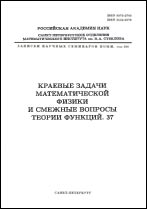|
|
Zapiski Nauchnykh Seminarov POMI, 2015, Volume 438, Pages 225–235
(Mi znsl6193)
|
 |
|
 |
This article is cited in 2 scientific papers (total in 2 papers)
On the Morse index calculation and the prolongation of the ray formulae beyond caustics
M. M. Popov
St. Petersburg Department of Steklov Mathematical Institute of Russian Academy of Sciences, St. Petersburg, Russia
Abstract:
Remaining to be the simplest and illustrative from the physical point of view, the ray method is extensively used for the computations of short wave fields of different physical nature: acoustic, electrodynamic and elastodynamic. However it is not applicable in the caustics neighborhood where ray amplitudes get singular. Although caustics may appear large in number in complex inhomogeneous media, they have zero measure and therefore there are free of caustics sub-domains in inhomogeneous medium where ray formulae can be used for the computations of the wave fields. For that aim we have to correctly calculate the phase jumps in ray amplitudes on caustics which the ray transverses on its way from the wave field source to the observation point.
According to mathematical terminology, we have to calculate Morse index for the ray, i.e. the number of focal points (with glance of their multiplicity) for the ray between the source and observation points. In the article this problem is considered and complete solution to it is given in case of two space variables. Namely, there is constructed such a complex-valued function of arc length along the ray which never vanishes on it and the increment of its argument between the source and observation point, being computed modulo $2\pi$, gives the Morse index for that ray for the both cases: when the rays are generated by the point source or by the initially given wave front.
Key words and phrases:
ray method, geometrical spreading, caustics, Morse index.
Received: 13.10.2015
Citation:
M. M. Popov, “On the Morse index calculation and the prolongation of the ray formulae beyond caustics”, Mathematical problems in the theory of wave propagation. Part 45, Zap. Nauchn. Sem. POMI, 438, POMI, St. Petersburg, 2015, 225–235; J. Math. Sci. (N. Y.), 224:1 (2017), 150–156
Linking options:
https://www.mathnet.ru/eng/znsl6193 https://www.mathnet.ru/eng/znsl/v438/p225
|

|




 Contact us:
Contact us: Terms of Use
Terms of Use
 Registration to the website
Registration to the website Logotypes
Logotypes








 Citation in format
Citation in format 
